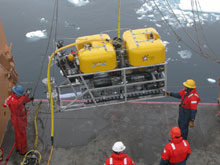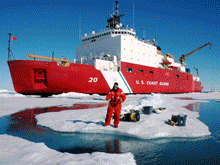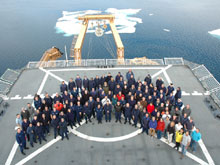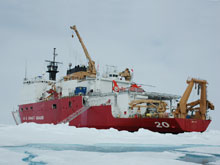
Bathymetric map showing the station locations and cruise track of the USCGC Healy during the Hidden Ocean expedition. Click image for larger view
View a visual collection of images from the The Hidden Ocean, Arctic 2005 Exploration.
![]() Click image to view a slide show.
Click image to view a slide show.
The Hidden Ocean Arctic 2005 Summary
July 26, 2005
Rolf Gradinger
University of Alaska Fairbanks
School of Fisheries and Ocean Sciences
The Hidden Ocean 2005 Expedition focused on assessing the diversity of life and the environment in all three major realms of the Arctic - the sea ice, the water column and the sea floor. For one month, 35 members of the science party and 75 Coast Guard crewmembers worked together on board the US Coast Guard Cutter Healy to conduct round-the-clock science operations. The team visited 14 stations covering poorly-known areas of the Southwestern Canada Basin, Northwind Ridge, Northwest Abyssal Plain and Chukchi Plateau. Core science operations included measuring sea ice properties, primary productivity, pelagic (water column) and benthic (seafloor) community composition. Utilizing a variety of methods and tools to conduct research, we encountered many amazing and surprising finds!
The sea-ice team conducted research on and underneath the ice. Ice corers were used to collect samples of ice that are being analyzed to estimate the diversity and quantity of sea ice algae (plant life) and fauna (animal life); many of these samples are still being processed as we search for rare and unidentified microscopic creatures living in the ice. Our understanding of the sea-ice realm was enhanced through the collection of temperature, salinity (saltiness), fluorescence and light profiles under the ice from all 14 stations. These measurements will help define the growing conditions for tiny, single-celled plants known as phytoplankton, which provide food for other microscopic animals and form the base of the food web. The growth rates of sea ice algae and phytoplankton were studied using primary production measurements conducted in situ (in the natural environment) in the water column under the ice. As the base in the Arctic marine food web, understanding the growth of phytoplankton is important to understanding of the amount of food available to creatures living at different depths under the ice.
Ice divers collected fascinating video and still images on the distribution of amphipods (small creatures living on the underside of the sea ice) and Arctic cod under the drifting pack ice. Two of the amphipod species studied were previously unknown to inhabit the region; one was known only as a pelagic species, and the other had been known only in association with coastal waters.

Built by Deep Sea Systems, Inc., the Global Explorer remotely operated vehicle (ROV) is equipped with 3 standard and 1 high definition camera, providing scientists with an eye into the sea. During the expedition, the ROV descended as deep as 9000 feet, collecting samples of creatures in the water column and on the deep seafloor; some of the creatures collected are new to science. Click image for larger view
The pelagic team focused on identifying unknown or poorly known gelatinous zooplankton animals and the organisms they feed on in the Canada Basin. Tools including live nets, a multi-net, and the "Global Explorer" Remotely Operated Vehicle (ROV) captured live specimens of zooplankton living from the surface to 9000 feet deep! Manufactured and quickly upgraded by Deep Sea Systems International for the expedition, ROV pilots skillfully maneuvered the ROV while scientists adjusted the on board camera to capture stunning high definition video footage of animals in the water column. The combination of these tools enabled us to succeed in making the first comprehensive observations of the small and large zooplankton community found down to 300 meters deep in the Arctic Ocean; we now have a detailed impression of the more common zooplankton species, the depth ranges over which they occur, and records of their appearance in their natural habitats. Numerous first records of many of these species in the Amerasian Arctic were recorded, 6-10 of which represent undescribed "new" species!
The benthic team utilized a variety of tools to view and sample the deep seafloor. The ROV performed a total of 8 benthic dives ranging from 880-2250 meters deep, collecting high definition video footage and samples of flora and fauna living on the deep seafloor. A photo platform was constructed and used for the expedition to conduct quantitative image sampling of the seafloor, and box cores were deployed to collect cookie-cutter like samples of the sea bottom and the creatures living within it. Among the species viewed and collected were at least seven polychaete (marine bristle worm) species marking significant range extensions in geographical area and/or depth; at least three suspected new species of polychaetes; and many more samples and species in need of further analysis before conclusions can be made.
The creatures living in the water were not the only subjects studied; a science team on board focused on characterizing the environments in which the creatures live through instrument deployments as well as in situ experiments. In addition to a winch operated CTD (conductivity, temperature, and depth sensor), one CTD was attached to the ROV and collected water mass characteristics to provide an oceanographic context for each sampling site; this information can be used to find where the water at each site originated from and help explain the observed species composition and nutrient regime in the Canada Basin. Deep CTD water samples were also collected and analyzed for nutrient and plant pigments to assess the environment and food available for animals living in the deep sea.
The combined research of all 35 participating scientists will help to create a more complete understanding of the Arctic food web from the sea-ice surface, deep down to the creatures living on the seafloor. This expedition represents the first comprehensive, multidisciplinary effort towards understanding and characterizing the diversity of life in all realms of the ice-covered Arctic Ocean. Many new and exciting discoveries were made while onboard, and many still await as we spend future months pouring through the wealth of samples collected during the expedition, and analyzing our results.
The cruise was exceptional, not only because of the success of our science mission, but thanks to everyone involved! Continuous support to the science mission provided by the Healy crew 24 hours a day, 7 days a week surpassed our expectations, helping make our day-to-day science missions very successful. The North Slope Borough Search and Rescue facility and the Barrow Arctic Science Consortium provided us with logistical support whenever we needed it, saving us many days of science time. The participating NOAA team provided tremendous logistical and practical support before, during and after the mission.
More questions continue to arise from our research; some of these were
discussed by the science team while onboard the ship - how many of the
new species discovered are also found in the Pacific? How many in the Atlantic?
And perhaps most pressing of all - have there been changes over the last
few decades? It appears that 2005 is going to be another year with Arctic
summer ice extent well below the long-term mean. Studies like this NOAA
cruise will not be able to answer all these questions, but the collected
data are urgently needed as baseline information to assess the impacts
of change on the Arctic marine environment.
The Census of Marine Life ![]() will provide the umbrella to put our observations in larger context.
Future science missions are needed to continue and extend
the work we had the pleasure of conducting this summer of 2005.
will provide the umbrella to put our observations in larger context.
Future science missions are needed to continue and extend
the work we had the pleasure of conducting this summer of 2005.
Sign up for the Ocean Explorer E-mail Update List.



































